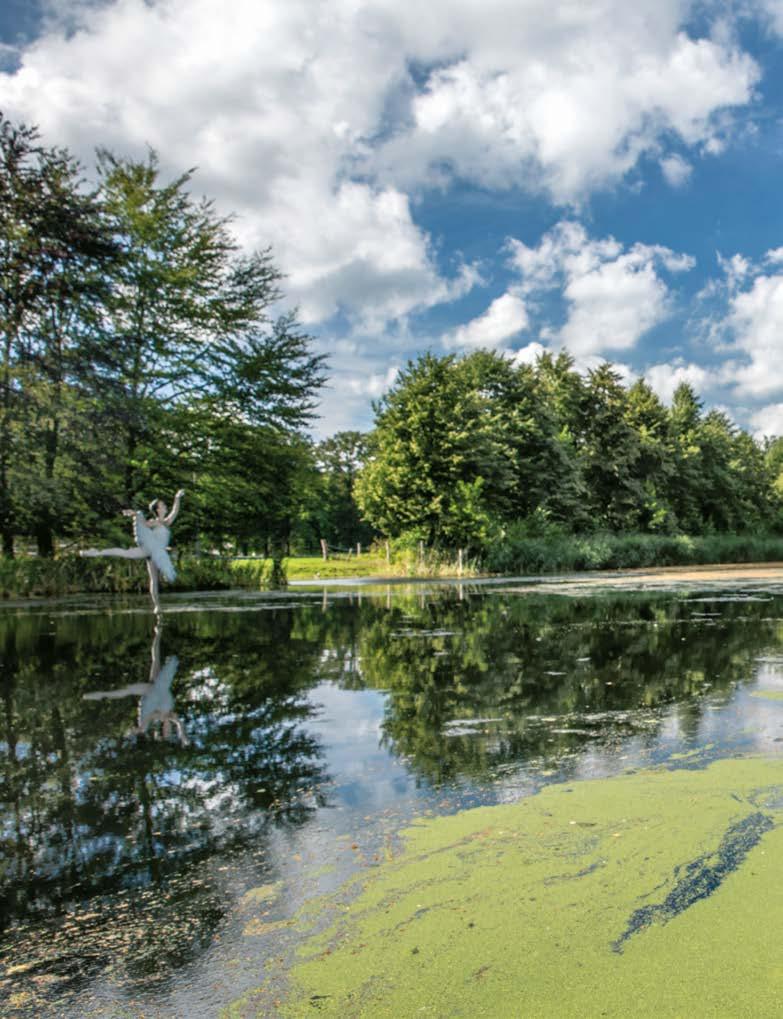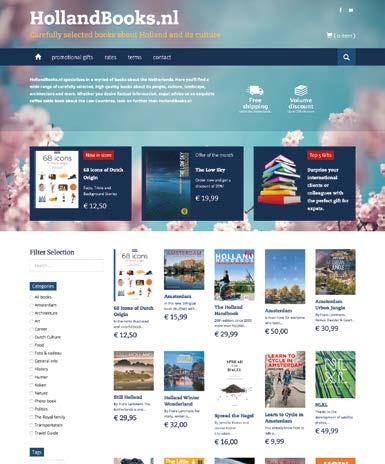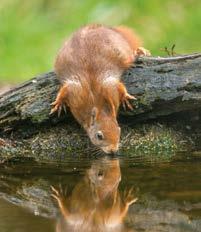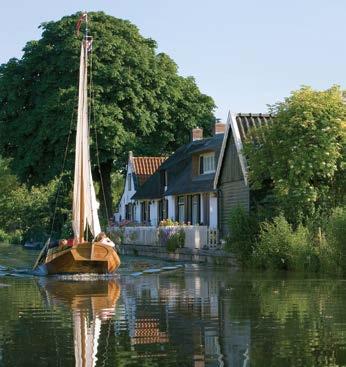
11 minute read
s-Graveland
’s-Graveland THE FORMER PLAYGROUND OF 17TH-CENTURY AMSTERDAMMERS
Every now and then, you have a day that is so perfect, you just don’t want it to end. The things you see, the people you meet, the information you absorb, the nature you experience, the history you witness – they all come together to create a magical day.
Advertisement
By Stephanie Dijkstra Photography Frans Lemmens



The day I visited ‘s-Graveland was one such day. It helped, of course, that I was taken on a tour of the village by a couple that has a true love for the area and knows every inch of it. A couple of years ago, after having lived in ‘s-Graveland for a decade while traveling around the world, Frans Lemmens – photographer for National Geographic – and his wife Marjolijn van Steeden decided that it was time to live somewhere else. Wherever their work or leisure sent them, they looked around – weighing the pros and cons; the culture, their knowledge of the language, the people, the history, the beauty of the environment... All continents were considered and potential homes were visited, when all of a sudden they realized; ‘s-Graveland – where they had been living all this time – was exactly where they wanted to be. And that is completely understandable.
Creature Comforts At less than 30 kilometers from the center of Amsterdam, it feels two centuries removed from the city. Not because of lack of civilization or creature comforts – but precisely because of creature comforts, literally; wide meadows, purple heathland, ample waterways and expansive woodlands offer sanctuary to a wide variety of animals, ranging from roe deer, to kingfishers, to bats, to bees, to storks, swans, owls – to name a few. Though it is located between Amsterdam and the country’s TV and radio capital of Hilversum, you can set off in any direction and encounter nothing but local flora and fauna in all its glory.
Wealthy Amsterdammers Since time immemorial, this area had been inhabited by farmers, who put their cattle out to pasture near Ankeveen in the summers, and then led them to the
34 | the xpat journal | 2020 heathland near Hilversum during the winters. Eventually larger farms were built, where the Amsterdammers – fleeing the stench of the inner city, liked to rent the top floor in the summers, out in the relative wilderness but nonetheless more than luxurious enough. They came there down canals that had been dug between Amsterdam and this area for the purpose of transporting sand to Amsterdam (and faraway Indonesia), to stabilize the ground under the houses, and garbage and dirty laundry to ‘s-Graveland. The laundry was washed in the clean waters of the village – an industry that thrived until well into the 20th century – and the garbage was dumped out in the countryside. At the start of the 17th century, a couple of wealthy Amsterdammers decided they wanted a place of their own along the canal, and on March 17, 1625, the decision was made to divide up an almost perfectly rectangular strip of land of approximately 600 hectares (or 1,500 acres) into plots for the purpose of allowing an influx of Amsterdammers make the area more ‘cultured’. ‘A couple of wealthy Amsterdammers decided they wanted a place of their own, and a strip of 1,500 acres was divided up’
Protest Of course, the local farmers were less charmed by this idea, presumably feeling they were ‘cultured’ enough, and decided to defend their area; they shot at the first laborers and set about destroying their work. In response, a small army of horsemen and infantrymen were sent to the area to keep the peace, until an agreement was reached with the locals; they would keep three throughways between Ankeveen and Hilversum for their cattle, and the path, leading from Ankeveen to the Catholic church in Hilversum would be maintained. Once this was settled, the construction of luxury homes, or manor houses, could begin. This path between Ankeveen and Hilversum, called Ankeveensepad, remains there
PRICE € 9 .99

Available at major book stores and webstores such as www.bol.com and www.hollandbooks.nl
For multiple orders contact XPat Media Tel.: 070 306 33 10 • E-mail: info@xpat.nl
www.hollandbooks.nl
Visit our shop HollandBooks.nl specializes in a myriad of books about the beautiful Netherlands. Here you’ll find a wide range of carefully selected, high quality books about Holland, its people, culture, landscape, architecture and more
Gifts Find the perfect present for your friends and family back home and the best selection of corporate gifts
Free shipping We do not charge shipping costs for deliveries within the Netherlands
Discounts Hollandbooks offers discounts up to 15% for multiple orders
Check our offer of the Month!
We are a Primary and Secondary school offering international education in English. We cater for students aged 4-19 and offer a highly reputable school programme called the International Baccalaureate (IB). Our school strongly believes in high quality and accessible education and we are able to offer our programmes at a highly competitive rate. We now have three locations in the Amsterdam area.
• The International Baccalaureate Diploma Programme (IBDP) for children aged 16-19 years • The International Baccalaureate Middle Years Programme (IBMYP) for children aged 11-15 years • The International Primary Curriculum (IPC) for children aged 4-10 years • Dutch language lessons
AICS Main Location 020 577 1240 (Amsterdam Zuid) AICS Satellite Location 020 723 4830 (Amsterdam Buitenveldert) AICS South East Location 020 723 5280 (Amsterdam Zuidoost) E: info@aics.espritscholen.nl
www.aics .espritscholen .nl

fully accredited by
GETTING THERE To reach ‘s-Graveland by public transportation, take the train to Bussum-Zuid and cut across the heath to Boekesteyn manor.
EATING THERE Local places to eat, recommended by our guides: • Restaurant Vlaar: www.restaurantvlaar.nl • De Colonie: www.sgraveland.colonie.nl • Brambergen: www.brambergen.nl • ‘t Swaentje: www.hetswaentje.nl • Bistro de Garde: www.bistrodegarde.nl • Restaurant Loodijk: www.restaurantloodijk.nl • Restaurant de Molen: www.restaurant-de-molen.nl
to this day and represents another twist in history; despite popular belief that everyone ‘above the rivers’ (Rhine/Lek, Maas and Waal) has always been protestant, this area was populated by Catholics. With the influx of Amsterdammers in the 17th century, ‘s-Graveland became a Protestant pocket in a predominantly Catholic area that interrupted the trek of Ankeveen’s religious folk to their church in Hilversum. SLEEPING THERE Local places to sleep, recommended by our guides: • Art+Bed and Breakfast • Rural Family Home • De Zanderij: www.beeldentuin-dezanderij.nl • Sperwershof: www.sperwershoferfgoedlogies.nl
Poldermodel ‘s-Graveland was also home to that quintessentially Dutch phenomenon: a polderbestuur, or polder government. Though created on the initiative of the local nobility, the hoogheemraadschap, as it was also known as in other parts of the country, became an institution that gave voice to a variety of interested parties, who – in consultation – strived for consensus on matters that were of interest to everyone. This is seen as an early form of democracy and has given rise to what is now known to typify the Dutch; the poldermodel.
Manors Currently, ten of the 17th-century manor houses remain, such as Boekesteyn, Trompenburgh and Schaep en Burgh. Some of them have become offices, some are privately owned and some are open to the public. Schaep en Burgh houses the head office of Natuurmonumenten, or Nature Monuments, which has bought and protects approximately 250,000 acres of natural area in the Netherlands, as well as managing 255 sites and owning 1,700 buildings. It is also housed in Huys

Brambergen, where Natuurmomumenten has an exhibition and (partially interactive) information center, as well as café-restaurant Brambergen. Here they purportedly sell the best apple pie in the country, which you can enjoy while taking in the wide views of the pastures and woodlands behind. And if you want your children to (re)discover what it is like to play outside, there is an OERRR play garden here as well, where they can climb in the tree hut, mess around with water, build things with sticks and branches – all the things children did before the advent of the TV and game consoles – while you enjoy a steaming cup of coffee on the terrace. Through OERRR, Natuurmonumenten arranges a variety of activities for children who want to explore more of nature; visit www.natuurmonumenten.nl/kinderen for more information and an agenda of their activities, for which you can sign up your children. Trompenburgh manor house is hard to miss; built for Admiral Cornelis Tromp, it rises like a ship out of the canal with a terrace right on the water’s edge and a roof balcony that – before there were woods – offered a view from the Dom Tower of Utrecht to the former Zuyderzee (IJsselmeer). Nowadays, you can book a tour-guide-led visit to the manor house, first come, first serve, via the Natuurmonumenten website. Boekesteyn houses the Gooi and Vecht Area Visitor’s Center, where you can find information on the ten adjacent manor houses and from where you set off on a hike through the area. You can download a 17-kilometer long hiking route on www. natuurmonumenten.nl/bezoekerscentrum-gooi-envechtstreek/route/wandelroute-s-gravelandse-buitenplaatsen.
Sculpture Garden An absolute high point of the day was a visit to Sculpture Garden (Beeldentuin) Zanderij. As the owner is a friend of my guides, he gave us a personal tour. Given



its name, it should come as no surprise that the garden is filled with sculptures – of all types, ranging from realistic, to African, Asian, modern and just about any style – that have been placed throughout the garden in a pleasingly seemingly random sort of way. When re marking that some of the sculptures appeared to have been knocked over, our host explained that, in an ticipation of that weekend’s storm, they had been laid down in order to keep them from falling over. However visible the art may be, it is only modest part of all you can experience there; in the middle is a rather curiouslooking structure that looks rather haphazardly put to gether, but that nonetheless apparently suits the taste of a variety of birds who have created their nests in its countless niches – including owls, whose pictures are also on display, photographed by none other than my host of the day. Off beyond that is the Toad Pool, home to toads, frogs, salamanders and grass snakes, while in the center of the garden is a bee pavilion, slightly sunken into the ground, that you can enter and circle, enjoying more art and the livelihood of the local bee population. Across from it is a cellar, which the own er opened with a key that looked at least as old as ‘sGraveland itself, to reveal the ideal hibernation place for a variety of bats. We spotted a few tiny fellas, hang ing upside down, wings tucked in, eyes closed as they waited for the warmer days of summer. Once again outside, we were led to the edge of the canal, with its Kingfisher Wall, which is enthusiastically made use of by its intended inhabitants. Having made many photo graphs myself of empty branches where, seconds before, a beautiful bird had been perched, Frans shared with me just how much preparation goes into his seemingly off-the-cuff, spontaneous nature photog raphy. First, he had to figure out which opening had a nest behind it. Then he had to set up a spot where the kingfisher was sure to stop when returning to the nest with food, to check out whether the coast was clear. Next, Frans had to set up the camera in such a way that the photographs were sure to be in focus. After that, he set up a tent on the other side of the canal, where he and his wife settled – chilly, yet cozy – for the day, remote control in hand, to operate the camera. That is when you realize that nature photography is not mere ly a matter of trekking through nature with a heavilytelelensed camera around your neck, but also a matter of planning, preparation and patience. The Zanderij adventure does not end there. When you have seen all there is to see in the garden, be sure to visit the tea room and terrace. Here, you can sit in the sun, with an unhindered view of the sculptures, birds and trees and enjoy high tea, mini tea or lunch (minimum number of guests required for all three). And if you still haven’t had enough, be sure to book a room upstairs, in their bed&breakfast. The entire complex is powered with solar panels. ‘An absolute high point of the day was a visit to Sculpture Garden (Beeldentuin) Zanderij’

Perfect Ending Just when I thought I had seen it all and we were driving back home through a descending curtain of dusk, we spotted a small group of roe deer in the meadows, untroubled by the close proximity of civilization, calmly making their way through a buffet of grass, leaves and twigs. It was the perfect ending to a perfect day.
ABOUT THE PHOTOGRAPHER Frans Lemmens has published several photography books, including Still Holland and Holland – Winter Wonderland. His book The Netherlands at Its Best, with 100 new pictures in a new and updated version, is due to appear in the month of April. It can be ordered at www.hollandbooks.nl










